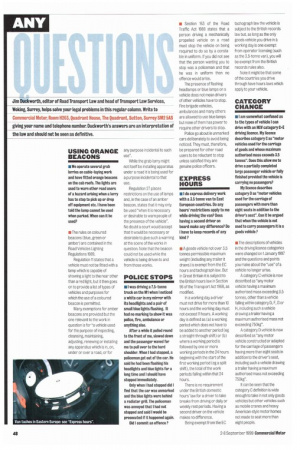Jim Duckworth, editor of Road Transport Law and head of
Page 50

If you've noticed an error in this article please click here to report it so we can fix it.
Transport Law Services, Woking, Surrey, helps solve your legal problems in this regular column. Write to Commercial Motor, Room H203, Quadrant House, The Quadrant, Sutton, Surrey SM2 54S giving your name and telephone number. Duckworth's answers are an interpretation of the law and should not be seen as definitive.
USING ORANGE BEACONS
• We operate several grab lorries on cable-laying work and have fitted orange beacons on the cab roofs. The lights are used to warn other road users of a hazard arising when a lorry has to stop to pick up or drop off equipment etc. I have been told the lamp cannot be used when parked. When can it be used?
• The rules on coloured beacons (blue, green or amber) are contained in the Road Vehicles Lighting Regulations 1989.
Regulation 11 states that a vehicle must not be fitted with a lamp which is capable of showing a light to the rear other than a red light, but it then goes on to provide a list of types of vehicles and purposes for which the use of a coloured beacon is permitted.
Many exemptions for amber beacons are provided but the one relevant to the work in question is for "a vehicle used for the purpose of inspecting, cleansing, maintaining, adjusting, renewing or installing any apparatus which is in, on, under or over a road, or for any purpose incidental to such use".
While the grab lorry might not itself be installing apparatus under a road it is being used for a purpose incidental to that use.
Regulation 27 places restrictions on the use of lamps and, in the case of an amber beacon, states that it may only be used 'when it is necessary or desirable to warn people of the presence of the vehicle". No doubt a court would accept that it would be necessary or desirable to give such a warning at the scene of the works in question. Note that the beacon could not be used while the vehicle is being driven to and from those works.








































































































